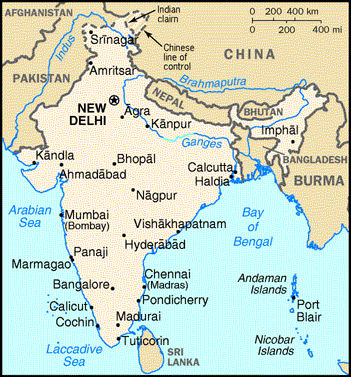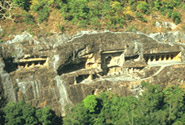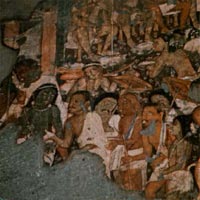|
Quiz:
|
|
|
|
2. What country is Ajanta in?

Inscribed :1983 Criteria: C (iii)
Brief Description:
~Reading Passage~
(1) The caves are in a wooded and rugged ravine about
3 J m from the village. Along the bottom
of the ravine runs the river Wagura, a mountain stream, which
forces its way into the valley over a bluff on
the east, and forms in its descent a beautiful waterfall, or
rather series of waterfalls, 200 ft. high, the sound
of which must have been constantly audible to the dwellers in
the caves
 These are about thirty in number, excavated
in the south side of the precipitous bank of the ravine, and
vary from 35 to 110 ft. in elevation
These are about thirty in number, excavated
in the south side of the precipitous bank of the ravine, and
vary from 35 to 110 ft. in elevation
above the bed of the torrent. The caves are two kinds of dwelling-halls
and meeting-halls. The former, as one enters from the pathway
along the sides
of the cliff, have a broad verandah, its roof supported by pillars,
and giving towards the interior on to a hall averaging in size
about 35 ft. by 20 ft.
(2) To left and right, and at the back, dormitories are excavated
opening on to this hall, and in the centre of the back, facing
the entrance, an image of the Buddha usually stands in a niche.
The number of dormitories varies according to the size of the
hall, and in the larger ones pillars support the roof on all
three sides, forming a sort of cloister running round the hall.
The meeting-halls go back into the rock about twice as far as
the dwelling-halls; the largest of them being 945 ft. from the
verandah to the back, and 415 ft. across, including tic cloister.
They were used as chapter-houses for the meetings of the Buddhist
Order.
 (3) The caves are in three groups, the
oldest group being of various dates from 200 B.C. to A.D.2oo,
the second, group belonging, approximately, to the 6th, and the
third group to the 7th century A.D. Most of the interior
walls of the caves were covered with fresco paintings, of a considerable
degree of merit, and somewhat in the style of the early Italian
painters. When first discovered, in 1817, these frescoes were
in a fair state of preservation, but they have since been allowed
to go hopelessly to ruin. Fortunately, the school of art in Bombay,
especially under the supervision of J. Griffiths, had copied
in colors a number of them before the last vestiges had disappeared,
and other copies of certain of the paintings have also been made.
These copies are invaluable as being the only evidence we now
have of pictorial art in India before the rise of Hinduism.
(3) The caves are in three groups, the
oldest group being of various dates from 200 B.C. to A.D.2oo,
the second, group belonging, approximately, to the 6th, and the
third group to the 7th century A.D. Most of the interior
walls of the caves were covered with fresco paintings, of a considerable
degree of merit, and somewhat in the style of the early Italian
painters. When first discovered, in 1817, these frescoes were
in a fair state of preservation, but they have since been allowed
to go hopelessly to ruin. Fortunately, the school of art in Bombay,
especially under the supervision of J. Griffiths, had copied
in colors a number of them before the last vestiges had disappeared,
and other copies of certain of the paintings have also been made.
These copies are invaluable as being the only evidence we now
have of pictorial art in India before the rise of Hinduism.
*一行目のJmとは地図上における、赤道方向に3インチの長さのこと。
引用サイト:World
Heritages
Notes
ravine
峡谷、谷間
cliff
絶壁、がけ
rugged
険しい、困難な
dormitory
眠る場所、寮
excavate
掘る、発掘する
niche
ニッチ、壁がん(像・飾りなどを置く壁面のくぼみ)
cloister
修道院
pictorial
絵画の、絵で表した
Web Sites
Tourismof
India:English Site
Indiatravel
Info:English Site
Budhist
Sites:English Site
Ajanta:India:
Japanese Site
♪India Information
Location: Southern Asia, bordering the Arabian Sea
and the Bay of Bengal, between Burma and Pakistan
Area comparative: slightly more than one-third the size
of the US
Climate: varies from tropical monsoon in south to temperate
in north
Natural resources: coal (fourth-largest reserves in the
world), iron ore, manganese, mica, bauxite, titanium ore, chromites,
natural gas, diamonds, petroleum, limestone, arable land
Population: 1,014,003,817 (July 2000)
Life expectancy at birth: total population; 62.5 years
(male: 61.89 years ,female: 63.13 years 〔2000〕)
Religions: Hindu 80%, Muslim 14%, Christian 2.4%, Sikh
2%, Buddhist 0.7%, Jains 0.5%, other 0.4%
Capital: New Delhi
Independence: 15 August 1947 (from UK)
Currency: 1 Indian rupee (Re) = 100 paise
Exchange rates: Indian rupees (Rs) per US$1 - 43.552 (January
2000), 43.055 (1999), 41.259 (1998), 36.313 (1997), 35.433 (1996),
32.427 (1995)
www.shejapan.com
> World
Heritages > Ajanta
by Jinju Hamasaki,
Aoyamagakuin College of Economics
2005 SHEJapan.com
